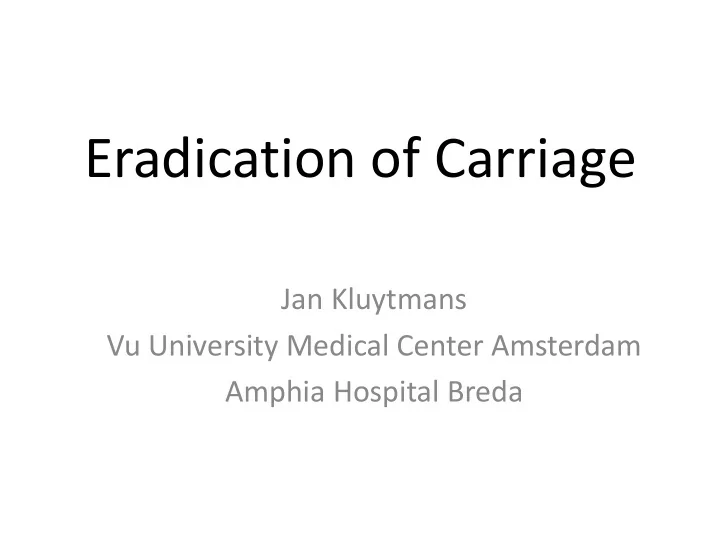

Eradication of Carriage Jan Kluytmans Vu University Medical Center Amsterdam Amphia Hospital Breda
Complicating factors • Carriage is not a disease • Carriage of specific pathogens increases the risk for development of disease (e.g. S. aureus) • Carriage is transmittable (patient dependency > possible herd effect) • Consequences for study design – Problems with individual randomization, blinding, meaningfull endpoints etc.
Two examples • S. aureus and SSI • Selective Decontamination of the Digestive Tract (SDD)
S. aureus and SSI • Carriers of S. aureus have an increased risk for the development of SSI after surgery (RR≈10) Kluytmans et al. Clin Microbiol Rev 1997 ; 10:505 - 520 • Peri-operative treatment with mupirocin reduces this risk (Risk Reduction≈60%) Bode et al. NEJM 2010;263:9 - 17
Cost-effectiveness • Cost reduction per treated carrier was – € 2841 in cardio -thoracic surgery – € 955 in orthopedic surgery Van Rijen et al. Plos One 2012;7:e43065
Savings 6
Mortality in cardiothoracic surgery 11/170 (6.5%) P=0.040 5/218 (2.3%)
Discussion • Mupirocin is cost-effective and reduces mortality • For which procedures should it be used? • Why not use povidone iodine, octinidine, or what else you can think of?
SDD • Patients in ICU • Topical antibiotics in oro-pharynx and GI tract (tobramycin, colistin and amphotericin B) • 4 days of systemic cefotaxim • Patient dependency • Blinding impossible – Multicenter cluster-randomized study De Smet et al. NEJM 2009;360:20 - 31
Infections and resistance
ICU-acquired bacteremia and candidemia
Acquired Respiratory Tract Colonization SC SOD SDD N=881 N=886 N=828 Tobramycin resistance: • Escherichia coli and Klebsiella spp 31 (3.5) 19 (2.1) 9 (1.1) • Other Enterobacteriaceae 25 (2.8) 41 (4.6) 15 (1.8) • Acinetobacter spp and S. maltophilia 40 (4.5) 45 (5.1) 49 (5.9) • Other GNF-GNR¶ 18 (2.0) 20 (2.3) 49 (5.9) • Any Gram-negative rods 104 (11.8) 112 (12.6) 115 (13.9) Cefotaxim resistance: • Escherichia coli and Klebsiella spp 13 (1.5) 12 (1.4) 2 (0.2) • Other Enterobacteriaceae 44 (5.0) 42 (4.7) 18 (2.2) • With any Enterobacteriaceae 56 (6.4) 56 (6.3) 20 (2.4) Colistin resistance: Proteus spp and Serratia spp 130 (14.8) 112 (12.6) 55 (6.6)
SDD • Reduces mortality • Prevents the development of bacteremia • Is associated with lower resistance rates • Limitations – Low prevalence of resistance (no MRSA) – Long term effects are unknown
Eradication of carriage • Can have substantial impact on clinical meaningful end-points • Is a preventive strategy and not a treatment of disease • Can be used to prevent the occurrence of disease in other persons (transmission)
Example • Recent outbreak of MRSA in oncology
Example • Source was a nurse who was colonized persistently with the outbreak strain – Is decolonization of the nurse justified? – Do we need effective agents for this? – Could new agents get a licence for this indication?
Recommend
More recommend